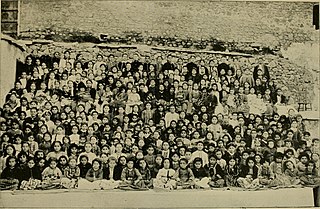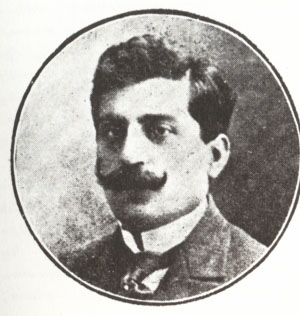Related Research Articles

Mehmed Talaat, commonly known as Talaat Pasha or Talat Pasha, was an Ottoman politician and convicted war criminal of the late Ottoman Empire who served as its de facto leader from 1913 to 1918. Talaat Pasha was chairman of the Union and Progress Party, which operated a one-party dictatorship in the Ottoman Empire, and later on became Grand Vizier during World War I. He was one of the perpetrators of the Armenian genocide and other ethnic cleansings during his time as Minister of Interior Affairs.
The Three Pashas also known as the Young Turk triumvirate or CUP triumvirate consisted of Mehmed Talaat Pasha (1874–1921), the Grand Vizier and Minister of the Interior; Ismail Enver Pasha (1881–1922), the Minister of War; and Ahmed Cemal Pasha (1872–1922), the Minister of the Navy, who effectively ruled the Ottoman Empire after the 1913 Ottoman coup d'état. According to historian Hans-Lukas Kieser, Talaat's power increased over time and eclipsed the others after 1913–1914.

Ahmet Rıza Bey was an Ottoman-born Turkish politician, educator, and a prominent member of the Young Turks, during the Second Constitutional Era of the Ottoman Empire. He was also a key early leader of the Committee of Union and Progress.
Jevdet Bey or Cevdet Tahir Belbez was an Ottoman Albanian governor of the Van vilayet of the Ottoman Empire during World War I and the Siege of Van. He is considered responsible for the massacres of Armenians in and around Van. Clarence Ussher, a witness to these events, reported that 55,000 Armenians were subsequently killed. He is also considered responsible for massacres of Assyrians in the same region.

Euphrates College was a coeducational high school in the Harput region, founded and directed by American missionaries and attended mostly by the Armenian community in the region.

Mehmed Reshid was an Ottoman physician, official of the Committee of Union and Progress, and governor of the Diyarbekir Vilayet (province) of the Ottoman Empire during World War I. He is infamous for organizing the wartime genocides of the Armenian and Assyrian communities of Diyarbekir. According to historian Hans-Lukas Kieser, despite being one of the worst perpetrators Reshid "is perceived as a patriot and martyr in official Turkish-nationalist diction".

Leslie A. Davis was an American diplomat and wartime US consul to Harput, Ottoman Empire from 1914 to 1917, who witnessed the Armenian genocide.

The Armenian reforms, also known as the Yeniköy accord, was a reform plan devised by the European powers between 1912 and 1914 that envisaged the creation of two provinces in Ottoman Armenia placed under the supervision of two European inspectors general, who would be appointed to oversee matters related to the Armenian issues. The inspectors general would hold the highest position in the six eastern vilayets (provinces), where the bulk of the Armenian population lived, and would reside at their respective posts in Erzurum and Van. The reform package was signed into law on February 8, 1914, though it was ultimately abolished on December 16, 1914, several weeks after Ottoman entry into World War I.

Vartkes Serengülian, was an Ottoman Armenian political and social activist, and a member of Ottoman Parliament.
Hans-Lukas Kieser is a Swiss historian of the late Ottoman Empire and Turkey, Professor of modern history at the University of Zurich and president of the Research Foundation Switzerland-Turkey in Basel. He is an author of books and articles in several languages.

Henry H. Riggs was a Christian missionary stationed in Kharpert during the Armenian genocide. In his book Days of Tragedy in Armenia: Personal Experiences in Harpoot, 1915-1917, Riggs provides an important eyewitness account of the Genocide and concluded that the deportation of Armenians was part of an extermination program organized by the Ottoman government. The book is considered to be one of the most detailed accounts of the Armenian genocide in the English language.

Witnesses and testimony provide an important and valuable insight into the events which occurred both during and after the Armenian genocide. The Armenian genocide was prepared and carried out by the Ottoman government in 1915 as well as in the following years. As a result of the genocide, as many as 1.5 million Armenians who were living in their ancestral homeland were deported and murdered.

Ruth Azneve Parmelee was a Christian missionary and a witness to the Armenian genocide. She served as a nurse of the American Women's Hospitals Service to a local hospital in Kharpert. She was also instrumental in the founding in 1922 of the hospital of the American Women's Hospitals Service in Salonika, Greece.

Hasan Tahsin Bey was an Ottoman and later Turkish bureaucrat and politician. Throughout his career as a politician, Tahsin served as a governor to several Ottoman cities including Aydın, Erzurum, Van and the province of Syria. Thereafter, he served as deputy to the cities of Ardahan, Erzurum, and Konya. During the Armenian genocide, he was complicit in the Kemah massacres. After the war, he provided important testimony on the genocide.

Mahmut Esat Bozkurt was a Turkish jurist, politician, government minister and academic. His birth name was Mahmut Esat. But after the adaptation of the Turkish Surname Law in 1934, he chose the surname Bozkurt in remembrance of the Grey Wolf, a symbol for Turkdom. The surname also refers to the Turkish steamer S.S. Bozkurt in the Lotus case. He was in the intellectual environment of the Turkish Hearths for almost two decades.

Talaat Pasha: Father of Modern Turkey, Architect of Genocide is a 2018 academic book by Hans-Lukas Kieser, published by Princeton University Press. It is a biography of Talaat Pasha. As of 2018 there had been no recent biographies of Talaat, nor of Enver Pasha, in western European languages. The book discusses the author's thesis that Talaat was co-Father of the Nation to modern Turkey along with Mustafa Kemal Atatürk, as well as Talaat's rule and significance.
Abdürrezzak Bedir Khan was an Ottoman diplomat, Kurdish politician and a member of the Bedir Khan family.
Ahmet Faik Erner (1879–1967) was an Ottoman Turkish bureaucrat and a member of the Committee for Union and Progress (CUP).
National economy is the economic plan envisioned by Ziya Gökalp and carried out by successive Ottoman and Turkish governments, which involved the systematic dispossession of native Christian bourgeoisie and their replacement by Muslim Turks, in addition to large-scale confiscation and redistribution of Christian-owned property. Türk Yurdu announced 1915 as the starting year of the national economy. To Emil Ludwig, Talaat Pasha mentioned that the loss of the Armenian workforce would damage the economy for a short while, but that Turks would step in their positions and replace the Armenians soon.

Hovhannes Bujicanian was an Armenian academic and teacher in the Ottoman Empire. He was a defender of the Second Constitutional Order within the Ottoman Empire and an influential functionary in the Euphrates College.
References
- 1 2 "Dr. Parmelee's Comments on some Euphrates College Profs and their Fate during the Armenian Genocide". groong.com. Retrieved 2021-04-06.
- ↑ Tachijan, Vahé (2015-09-28). Kieser, Hans-Lukas (ed.). World War I and the End of the Ottomans: From the Balkan Wars to the Armenian Genocide. Bloomsbury Publishing. pp. 212–213. ISBN 978-1-78453-246-8.
- ↑ "Home :: Houshamadyan - a project to reconstruct Ottoman Armenian town and village life". www.houshamadyan.org. Retrieved 2021-04-06.
- ↑ Tachijan, Vahé (2015-09-28). Kieser, Hans-Lukas (ed.), pp.2014–215
- 1 2 Tachijan, Vahé (2015-09-28). Kieser, Hans-Lukas (ed.), p.215
- ↑ Tachijan, Vahé (2015-09-28). Kieser, Hans-Lukas (ed.), p.220
- ↑ Tachijan, Vahé (2015-09-28). Kieser, Hans-Lukas (ed.), p.216
- ↑ Tachijan, Vahé (2015-09-28). Kieser, Hans-Lukas (ed.), pp.221–222
- ↑ Atkinson, Tacy (2000). The German, the Turk and the Devil Made a Triple Alliance: Harpoot Diaries, 1908-1917. Gomidas Institute. p. 41. ISBN 978-1-903656-00-6.
- ↑ Tachijan, Vahé (2015-09-28). Kieser, Hans-Lukas (ed.), p.232
- 1 2 Tachijan, Vahé (2015-09-28). Kieser, Hans-Lukas (ed.), p.219